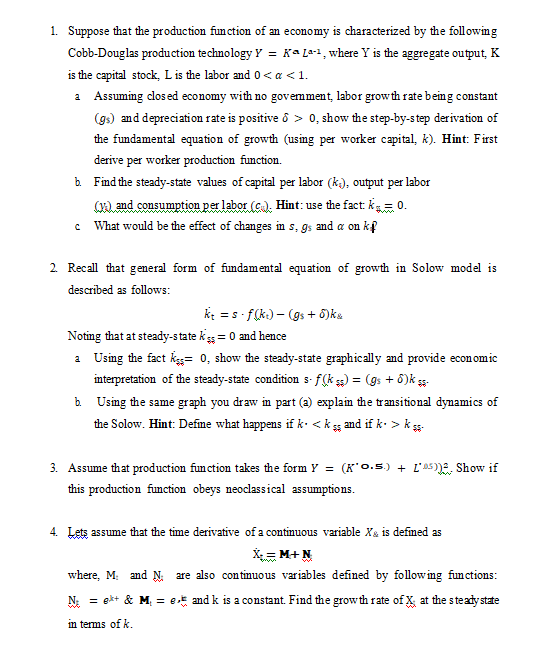1. Suppose that the production fumction of an economy is characterized by the foll owing Cobb-Douglas production technology Y = Ka L*•i, where Y is the aggregate output, K is the capital stock, Lis the labor and 0 0, show the step-by-step derivation of the fundamental equation of growth (using per worker capital, k). Hint: First derive per worker production function. a Find the steady-state values of capital per labor (k), output per labor (). and consumption per labor (c). Hint: use the fact k= 0. c What would be the effect of changes in s, g; and a on kf
1. Suppose that the production fumction of an economy is characterized by the foll owing Cobb-Douglas production technology Y = Ka L*•i, where Y is the aggregate output, K is the capital stock, Lis the labor and 0 0, show the step-by-step derivation of the fundamental equation of growth (using per worker capital, k). Hint: First derive per worker production function. a Find the steady-state values of capital per labor (k), output per labor (). and consumption per labor (c). Hint: use the fact k= 0. c What would be the effect of changes in s, g; and a on kf
Principles of Economics 2e
2nd Edition
ISBN:9781947172364
Author:Steven A. Greenlaw; David Shapiro
Publisher:Steven A. Greenlaw; David Shapiro
Chapter20: Economic Growth
Section: Chapter Questions
Problem 9SCQ: Would the following events usually lead to capital deepening? Why or why not? A weak economy in...
Related questions
Question

Transcribed Image Text:1. Suppose that the production function of an economy is characterized by the following
Cobb-Douglas production technology Y = Ka L*1, where Y is the aggregate output, K
is the capital stock, L is the labor and 0< a <1.
a Assuming dosed economy with no govemment, labor growth rate being constant
(gs) and depreciation rate is positive ô > 0, show the step-by-step derivation of
the fundamental equation of growth (using per worker capital, k). Hint: First
derive per worker production function.
b. Find the steady-state values of capital per labor (k), output per labor
(), and consumption per labor (c). Hint: use the fact: k= 0.
What would be the effect of changes in s, gs and a on kf
2. Recall that general form of fundamental equation of growth in Solow model is
described as follows:
k = s - f(k.) – (gs + 6)ka
Noting that at steady-state kss = 0 and hence
a Using the fact kes= 0, show the steady-state graphically and provide economic
interpretation of the steady-state condition s- f(k s) = (gs + 6)k *
b Using the same graph you draw in part (a) explain the transitional dynamics of
the Solow. Hint: Defime what happens if k. <k s
and if k- > k s-
3. Assume that production fumction takes the form Y = (K'0.5) + L'as)E, Show if
this production function obeys neoclassical assumptions.
4. Lets assume that the time derivative of a continuous variable Xa is defmed as
X = M+N
where, M: and N: are also continuous variables defined by following functions:
N: = ekt & M, = et and k is a constant. Find the grow th rate of x at the steady state
in terms of k.
Expert Solution
This question has been solved!
Explore an expertly crafted, step-by-step solution for a thorough understanding of key concepts.
Step by step
Solved in 2 steps with 6 images

Knowledge Booster
Learn more about
Need a deep-dive on the concept behind this application? Look no further. Learn more about this topic, economics and related others by exploring similar questions and additional content below.Recommended textbooks for you

Principles of Economics 2e
Economics
ISBN:
9781947172364
Author:
Steven A. Greenlaw; David Shapiro
Publisher:
OpenStax

Principles of Economics 2e
Economics
ISBN:
9781947172364
Author:
Steven A. Greenlaw; David Shapiro
Publisher:
OpenStax